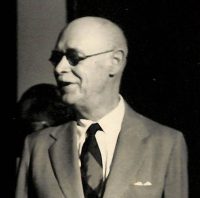Back in Zamboanga. About 11 o’c off for Basilan, which was “non-Christian territory” in my time. Rough crossing to Isabela. I had visited there 20 years ago when the only plantation was that of Menzi (Behn, Meyer & Co.)–the pioneer rubber plantation in the Philippines. Then we went only 300 yards from the harbour to see the old Spanish fort and the Spanish naval hospital built on stilts over the sea. Today we motored on a first-class road 9 kilometers to the United States Rubber Co. plantation managed by Dr. Strong. Magnificent coconut groves and miles of splendid rubber trees. The market for their rubber is entirely in the Philippines–in Japanese owned factories for making rubber-soled shoes etc. The plantations are now cramped by the lumber concession of Künzle and Streiff. Arthur Fischer, Director of Forestry, will not allow more plantation land to be taken from the forest. Clearings that have been made were done by raising a platform twenty feet from the ground and then sawing off the tree; gigantic trunks were left standing and then burned, which is a frightful waste of good lumber!
Strong and Menken have 400 laborers–from a Yaktan tribe of Moros, who are now mostly Christians. They are of pure Malay type wearing picturesque costumes. Strong says he has never carried a weapon in his thirty years there. Both men love their present way of life and would hate to have spent their years indoors in an office. A Yaktan dance was given for us–derived from the Siamese-Bali etc.; the movement is all hands and wrists–hardly any body rhythm–syncopated time is beaten by the feet. They chanted: “Maida–ling a ling da’ling.” No instrumental music. The dancers sang.
Doria asked if there were no “beach-combers” on this enchanted isle–none; “well then, where is Robinson Crusoe?” Sure enough, there is such a person on Basilan; a Doctor, retired from the United States Navy who is rich, and goes once a year to the United States to buy four or five boxes of books and then returns to live in the jungle, sans clothes, sans shoes and eating camotes. As is to be expected, alcohol is said to be his recreation in idle moments.
Mangrove swamps–probably alive with crocodiles; astounding groves of coconuts. Alano’s plantation is on the smaller island opposite.
A launch chartered by Dr. Strong came down to meet the Arayat, but the sea was too rough to board the vessel so our steamer went straight up the river. The launch followed flying a big flag with an Arabic inscription–Strong hoped Quezon would not notice this flag: “I told the Moros to decorate the launch and the lousy fellows put up that flag!” Evidently this was the end of an era for them, and they didn’t know it!
Miss Karagdag, with her father and mother, were on this trip.
Back to Zamboanga where more festivities are planned which I hope to duck.
Visit from Admiral Yarnell and return visit of Quezon dressed in riding clothes and flourishing a crop to the American cruiser Augusta–salutes etc. Buffet supper on Augusta given by the wardroom. Admiral very affable; he is a brilliant man. I had a long talk with him about Rossshire and Inverness where the Admiral was stationed during part of the War. Also had a talk with the Chief Signal Officer about fishing. Later there was a dance at the Overseas Club which I managed to escape.
Colonel Stevens of the Zamboanga Constabulary is a fine type of frontiersman, was a Lieutenant in my time, and says that after we removed the Military Government from Mindanao and Sulu, there were for a time, just as many excitements as before, but there was no publicity about it such as the army had always given. Now, all is absolutely tame and settled.
There are few young men among the civilian whites in Zamboanga; mostly these are “Old Timers,” now in business.
I note the predominance of Southerners in our army and navy–this should produce a fine fighting type.
We did not get away from Zamboanga until 4 a.m.
